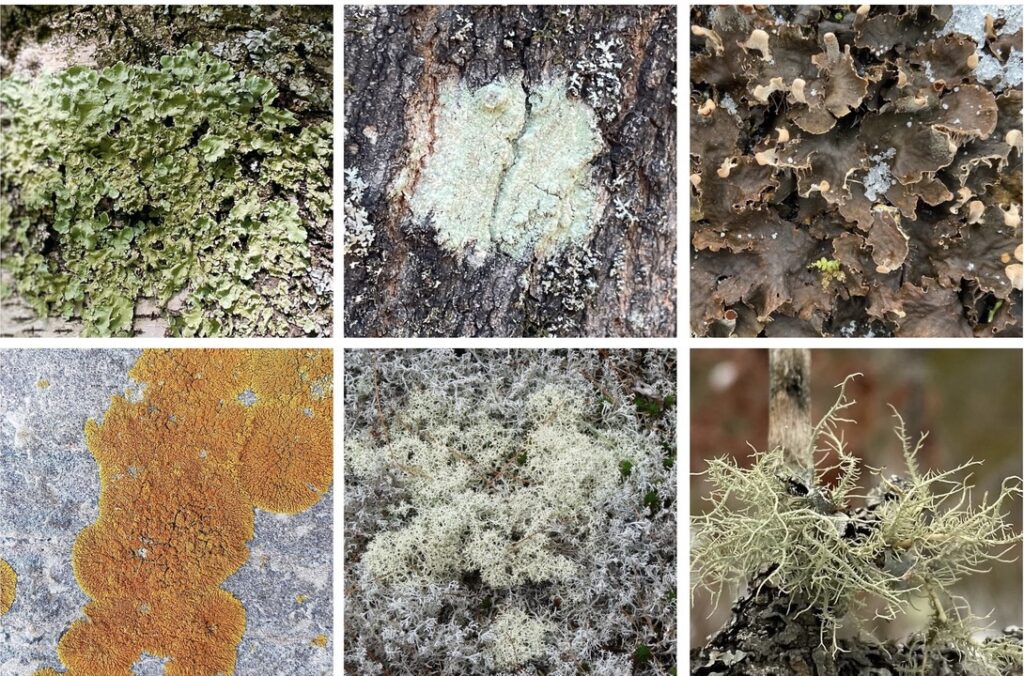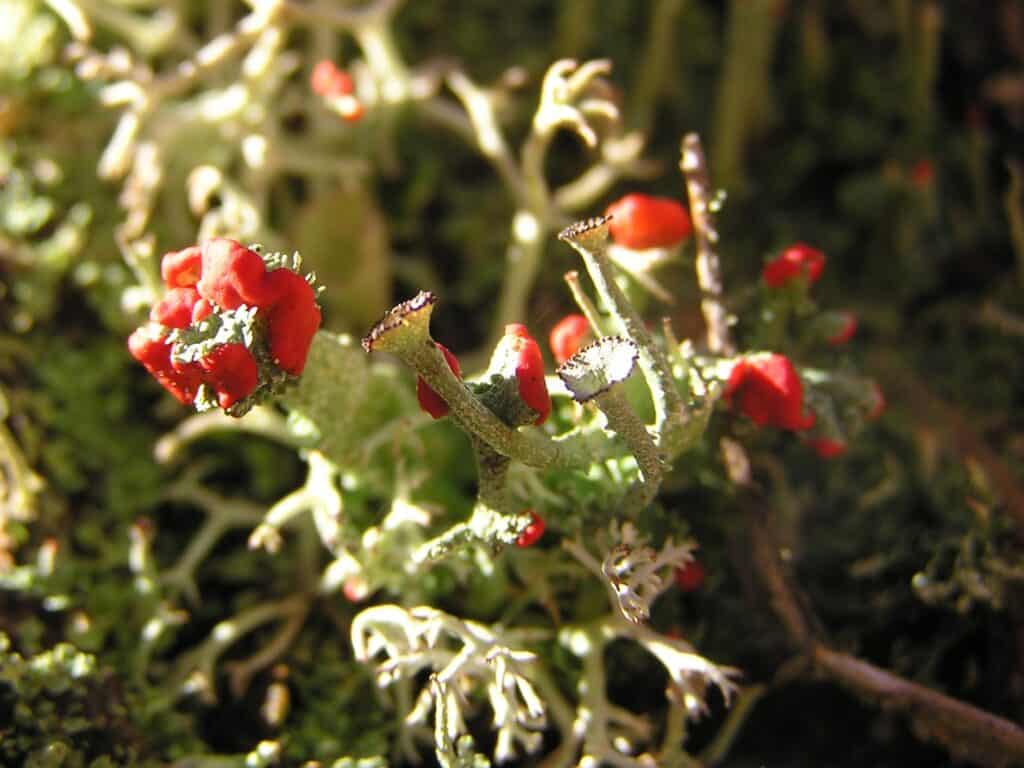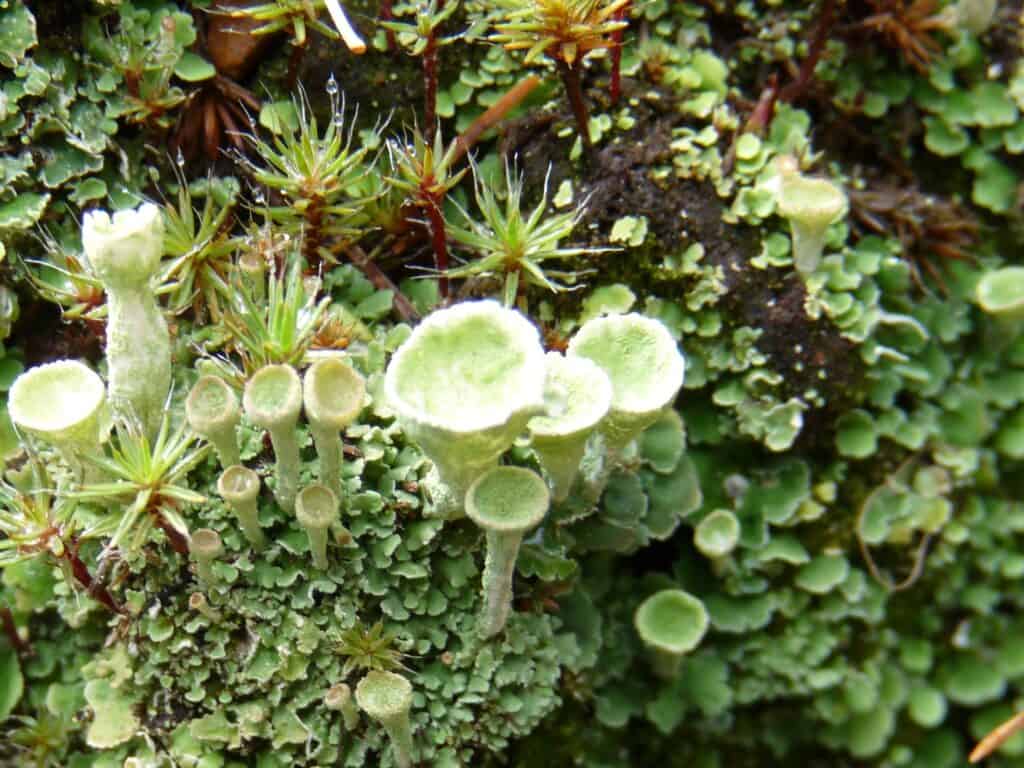The Kawarthas is home to over 500 lichen species. Fall is a great time to get to know them.
Peterborough Examiner – November 3, 2023 – by Drew Monkman
Of all the common organisms of the Kawarthas, lichens are perhaps the most overlooked. Although they’re small, when you pay attention you’ll see them everywhere, maybe starting with those curious, crusty green patches on the bark of trees in your own yard. In fact, Ontario is home to over 500 species, all of which can be seen year round. With fewer plants and animals to catch our attention right now, late fall is a wonderful time to explore these fascinating life forms.
For starters, lichens love inhospitable places. Where they grow is often the first step in identification. Some flourish on bare soil, rotting logs, old brick walls, and even sun‑scorched rocks and cliffsides. Others prefer the bare bark and branches of deciduous and coniferous trees. Old trees usually have the most lichen diversity. However, because they lack roots, stems and leaves, they take nothing from their host – just a bit of real estate.
These are complicated organisms and there’s much we don’t know. Some are plant-like but they are not plants. In simple terms, lichens are actually two or even three organisms cohabitating as one. They consist of a fungus, an alga and/or a cyanobacterium (blue-green alga). The latter two components – the “photobionts” – use sunlight to photosynthesize glucose both for themselves and for the fungus. Fungi are incapable of making their own food. In turn, the fungus provides a home and protective cover for the photobionts, sheltering them from damaging ultraviolet rays. This type of mutually beneficial relationship in nature is called symbiosis. In many ways lichens are better thought of as well-balanced ecosystems than as individual organisms. Trevor Goward, a lichenologist, describes them as “fungi that have discovered agriculture.”

Three growth forms
Lichens are divided into three subgroups, based on differences in growth form. Crustose lichens often bring to mind powder or paint sprayed on a tree or rock. Foliose lichens look somewhat like leaves and often have cup-like fruiting bodies that produce spores. Fruticose lichens resemble shrubby growths, which stand upright or hang from branches.
It’s often difficult to identify lichens to the species level. You may have to be satisfied by just recognizing the genus (the first word in the scientific name) or the group (e.g. shield lichens). I recommend purchasing “Lichens of the North Woods” by Joe Walewski. This wonderful field guide organizes lichens by substrate (ground, rock and tree), then within each substrate group by growth form.
The following are some common lichens of the Kawarthas. On tree bark, the most obvious species are usually the foliose shield lichens like common greenshield (Flavoparmelia caperata). It has pale-green lobes with a black lower surface and resembles a thin, flat, leafy circle. Common script lichen (Graphis scripta) is similar but usually whitish grey in colour with black marks that look like writing. A crustose species to look for is fluffy dust lichen (Lepraria finkii). It is yellowish-green to pale mint in colour and resembles paint on the bark. As for fruticose species, bristly beard lichen (Usnea hirta) can be found on the branches of sick or dying conifers like spruce. It has yellowish-green, densely branched, erect stems.
On rocks, watch for rock tripes (Umbilicaria species) and sunburst lichens (Xanthoria species), which are both foliose. Rock tripes look like dark, leathery lettuce leaves while sunbursts have abundant orange disks. Ashy-grey cinder lichen (Aspicilia cinera) is a common crustose species.
On the ground, you may come across the easily-identifiable British soldiers (Cladonia cristatella). With greenish-grey stalks and bright red caps, this fruticose species is named for its resemblance to the uniforms worn by English soldiers during the Revolutionary War. Trumpet lichen (Cladonia fimbriata) often grows alongside British soldiers and has a trumpet shape. Reindeer lichens (Cladina species) also grow on the ground and belong to the fruticose group. They resemble tiny white, grey or greenish shrubs or coral with numerous branches. Carpets of Cladina can cover huge areas. A common foliose genus, the pelt lichens (Peltigera species) have semi-erect, grey-green to brownish lobes and superficially resemble rock tripe.


Importance
Lichens are no less than the first building block of forests. By degrading rock surfaces and providing a site where organic material can collect, lichens begin what’s known as ecological succession – the process by which the mix of species and habitat in an area changes over time. When the last ice age retreated from the Kawarthas about 11,000 years ago, all that remained was a barren, mostly lifeless landscape of exposed bedrock, gravel and silt. Lichens were the first pioneer species to arrive, attaching themselves tightly to the rock. When lichens are wet, they expand; when they dry out, they contract. This causes miniscule flakes of rock to break off. They also secrete acids which disintegrates rock over time. And so begins the process of soil formation. As the lichen grows, these processes speed up and occur over an ever‑expanding area. Eventually, mosses, followed by ferns and grasses may take root in the modest accumulation of soil and replace the lichen. Over time the soil becomes deep enough to support shrubs and eventually trees. You can often see this process happening on boulders and rocky cliffs.
The importance of lichens doesn’t stop there. Ruby-throated hummingbirds use shield lichens (Parmelia) to camouflage their nests; deer, moose, caribou and even flying squirrels eat lichens; and gray tree frogs take advantage of the camouflage lichens provide. Their skin literally looks like lichen.
The degree of lichen diversity in a given area is also a good “bio-indicator” of the amounts of certain pollutants in the air. Some lichens are especially sensitive to sulfur dioxide which can kill them. It’s therefore possible to estimate the amount of sulfur dioxide in the air by observing the number and type of lichens growing in an area.
Activities
Maybe the most important reason to appreciate lichens is simply for their beauty. Take time to look at them through a magnifying glass or hand lens. An astonishing world is revealed.
Photographing lichens is a great pastime, too. All you need is your phone. Once you have a picture, use the free iNaturalist app to help with identification and to record and share your observations. If you go to the iNaturalist Explore page at https://www.inaturalist.org/, you can check if a given species has already been observed in your area. Challenge yourself to see how many species (or genera) you can find.
Sue Paradisis, president of the Peterborough Field Naturalists, encourages people to look for lichens on the trees in their own neighbourhood. “Take a picture of what you find and enlarge it on your phone. You’ll be amazed,” she says. A favourite spot of hers to find and photograph lichens is Kawartha Highlands Signature Park, located 2 km north of Buckhorn. “I’ve taken a group there for several years and we find lots of different species while enjoying a beautiful hike along the Mississauga River,” she told me.
Sue is co-leading a lichen outing to Kawartha Highlands tomorrow, Nov. 4, with Louis Smyrlis. Two spots remain. Contact her at sueparadisis@hotmail.com.
CLIMATE CHAOS UPDATE
Hope: Trent University is considering leasing a portion of its lands to allow for the creation of a battery energy storage system. The announcement follows a similar proposal for a facility, possibly in Selwyn Township. These storage systems store energy overnight when the provincial grid is producing the lowest cost and lowest carbon energy. The stored energy can then provide power at strategic times when the Ontario system operators typically turn to gas-fired generation to meet high demand. Trent has identified a four to eight hectare site on the hydro corridor on the east bank as an optimal location. See https://rb.gy/d584l
Carbon dioxide: The atmospheric CO2 reading for the week ending October 28, 2023 was 418.91 parts per million (ppm), compared to 416.19 ppm a year ago. Ten years ago (2012), the level was 391.09 ppm. Rising CO2 means more climate catastrophes and record warmth ahead. October in Peterborough was 3.3 C warmer than the 1971-2000 normal. Only three months this year have been cooler than average.